The LG G4 Review
by Joshua Ho on July 30, 2015 10:00 AM EST- Posted in
- Smartphones
- Qualcomm
- LG
- Mobile
- Snapdragon 808
- LG G4
Battery Life/Power Analysis
Battery life continues to be one of the most important aspects of any mobile device. It can often make or break a device, especially when flagships these days are increasingly designed to represent the best of all worlds for an end user. As a result, there will always be a need for battery life tests as smartphones continue to last around a day or two at best.
In order to test this, we turn to our standard suite of battery life tests that test for the most common use cases in a smartphone. In order to ensure that we’re making proper relative comparisons, we also calibrate all devices to a standard 200 nits to make sure that we aren’t unfairly penalizing a device based how an OEM decides to set their brightness curve on a percentage scale. For 2015, we’ve added the PCMark battery life test, which attempts to find a middle ground between the strongly display-bound web browsing test and the almost purely SoC bound throttling tests.
Normally, we'd dive straight into the battery life analysis. However, in the interest of providing some extra context to our battery life results we'll start by looking at display power, which will allow us to get a good idea for what exactly is affecting battery life. However, it's important to understand that the display is affected by Content-adaptive backlight control (CABC), which will reduce the backlight power and reduce gamma in order to attempt to reduce power consumption. This means that tests like PCMark and GFXBench will have a lower display power component than would be expected from the following power measurements.
In order to obtain these values, we set the brightness to meet a certain value at the approximate center of the display, then disabled all possible applications, enabled airplane mode, and set the display to show a full white image while idling. Measurement of power was taken at the fuel gauge ten times a second over the course of at least 30 seconds, and between each recording period the phone was placed in deep sleep to alleviate issues with die temperatures affecting power readings. Once we do this, we get the following results.
As one can see, the minimum brightness of ~4 nits has an idle power consumption of 519 mW. This is somewhat concerning, as despite the use of panel self-refresh (PSR) on LG's part, idle power consumption is still easily around double that of the HTC One M8. However, to LG Display's credit the 1440p display of the G4 is efficient and decreases the 161 mW deficit that it starts with relative to the Galaxy S6 down to 55 mW by the 200 nit mark and keeps going from there. Given that power scales linearly with brightness it's likely that brightness scaling is simply accomplished by PWM (pulse width modulation) similar to AMOLED devices that we've examined. Comparing this to our previous review in which we found that the G3 uses 1415 mW (or 560 mW more) on a blank white display at 200 nits, and it's clear that LGD has made some enormous improvements to power efficiency over the course of a year.

Our first test is web browsing, and here the LG G4 manages to surprise. A combination of a much-improved display and a well-implemented SoC on TSMC’s 20nm process seems to have solved most of the penalty that comes with a 1440p display with RGB stripe.
Battery life in this scenario isn’t quite as good as devices like the OnePlus One, although I suspect in practice SoC and modem efficiency will be more heavily weighted than it is in this test. We can actually see that the display is the main contributor to power consumption here, as if we assume that the battery has the typical 11.6 WHr capacity, this means that the average power consumption past idle display is 165 mW. Comparing this to the LG G3 (which has brightness reduction) means that on average the G4 reduced power consumption by about 442 mW, which suggests that the SoC has either unchanged or reduced power efficiency relative to Snapdragon 801 in this test although absent proper testing (not with a fuel gauge or at a power outlet) it's hard to say for sure here.
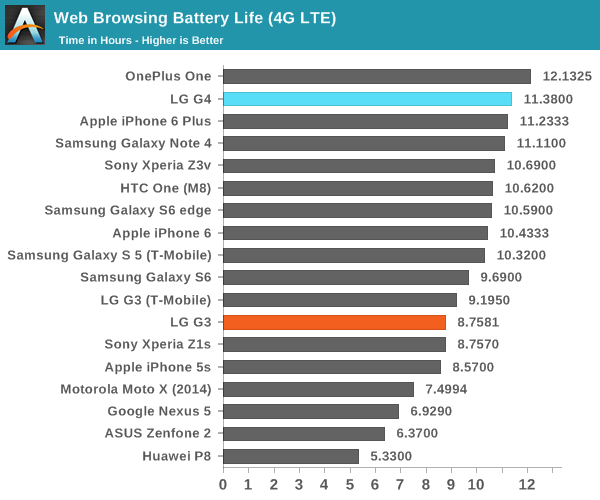
In LTE web browsing, we can really see the value of Qualcomm’s modem, as with Snapdragon 808 LTE web browsing is effectively identical in battery life to WiFi web browsing. There’s been a lot of talk recently of companies displacing Qualcomm in the modem space but it seems that for high-end devices Qualcomm remains the best choice when accounting for power efficiency of modem implementation. Unfortunately, the details of how Qualcomm pulls this off are a closely guarded secret, so all we really know is that a combination of better modem code, modem architecture, standards implementation, and layout contribute to Qualcomm’s lead here.
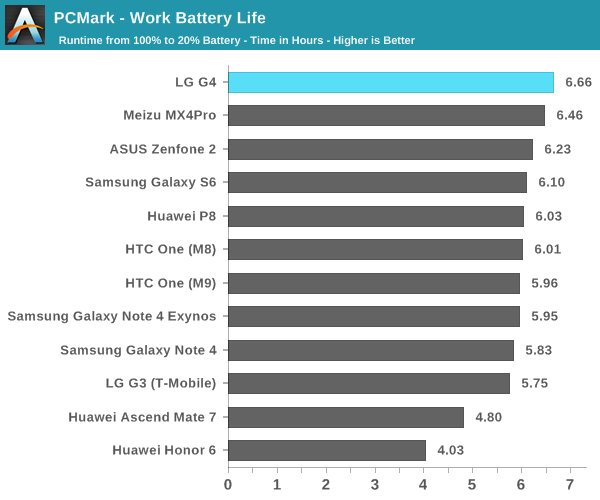
Moving on to more SoC-bound tasks, we can take a look at PCMark first. Here, we see that the LG G4 manages to significantly improve over other devices like the HTC One M9 in both runtime and score throughout the test, which definitely suggests that there is a noticeable perf/W delta between S808 and S810. Given the difference in performance, it's probably fair to say that the total work done is comparable between the Galaxy S6 and G4, but the G4 has a larger battery relative to the display size.
Now that we’ve looked at battery life through a suite of everyday tasks that tend to be display-bound or balanced between SoC and display, we can look at SoC-bound tasks that are either focused on the CPU or GPU.
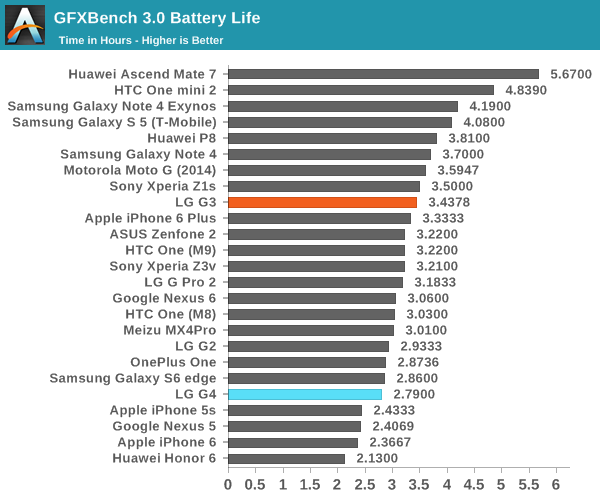
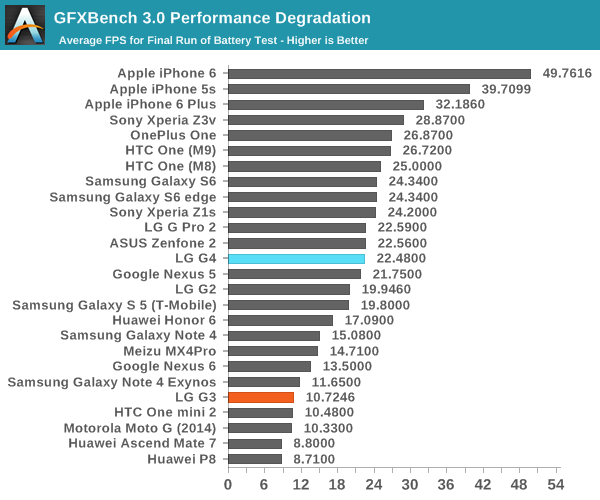
In GFXBench, we can see significant advantages from LG’s choice of the Snapdragon 808 SoC over the Snapdragon 810. The runtime ends up noticeably shorter than something like the One M9, but the frame rate is far more consistent and relatively higher than the M9 accounting for the higher rendering resolution, although I'm not sure whether it makes sense to have this sort of sinusoidal GPU performance outside of compute/race to sleep workloads. In sustained workloads it appears that the Adreno 418 is effectively comparable to the T760MP8 of the 7420 despite the process node advantage of the Exynos 7420. Given that the on-screen content of T-Rex is relatively low in average picture level, the AMOLED display accounts for at least some of the deficit between the GS6 and G4 in this test as well.

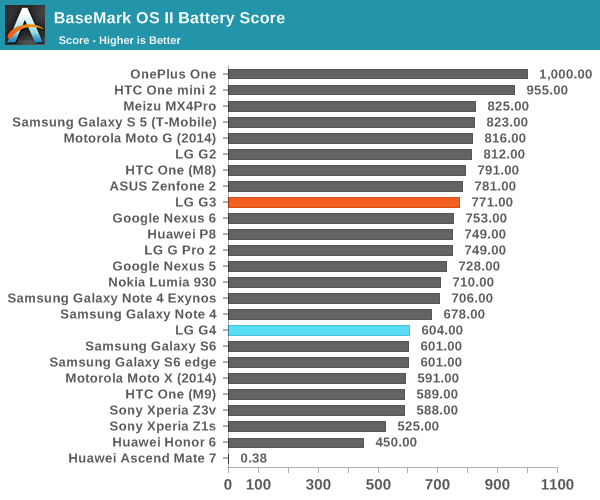
In Basemark OS II, we continue to see why LG has chosen to go with the Snapdragon 808. Although the battery performance is comparable to the One M9 here, in practice sustained performance is higher as the test manages to stay on the A57 cluster at around 800-600 MHz rather than dropping off to the A53 cluster from thermal throttling. The Galaxy S6 is still the winner here as it can keep two extra A57s at around 1-1.2 GHz in this test, but once again it’s important to emphasize that Qualcomm has a pretty significant process disadvantage here due to the use of planar transistors and a larger feature size. We’ve discussed the advantages of FinFET before in articles, and those interested in learning more can refer to our introduction to the topic, but the key here is that FinFET and other multiple-gate technologies are really the key to driving better performance.
Overall, the LG G4’s battery life is worthy of praise. In everyday use battery life is comparable to the Galaxy S6, and display-bound, high APL tasks will see a noticeable advantage over the Galaxy S6. In compute-bound tasks the G4 does lag behind the Galaxy S6, but the gap is nowhere near as large as it is with Snapdragon 810. Obviously, there will be some performance deficit due to the weaker GPU and fewer big CPU cores, but given the battery life advantages it seems LG has made the right trade-off here. It's also interesting to see here how in the G3 the SoC was making up for an efficiency deficit while in the case of the G4 the display seems to be making up for the SoC's efficiency deficit.
Charge Time
Although battery life is usually the most important aspect of staying mobile, charge time is often the other side of the equation and in any situation where minutes count charge time directly influences the effective runtime. There are a number of obvious situations where people can forget to charge their phones or are otherwise unable to charge their phones ahead of time. I’ve definitely had cases where I either forgot to put my phone on the charger before I went to sleep, or I had thirty minutes to charge my phone before a long flight.
In order to test this kind of use case, we look at how fast it takes for the phone to charge from 0% to 100% using the included charger. In the case of the G4, this means a 5V, 1.8A charger. However, it seems that the variants of the G4 on sale now will support Qualcomm’s QC 2.0 which could bring down charge times if the included charger isn’t enough. In order to test this, I monitor power at the outlet logged once per second to see the point at which charging corresponds to 100% charge to find the total time.
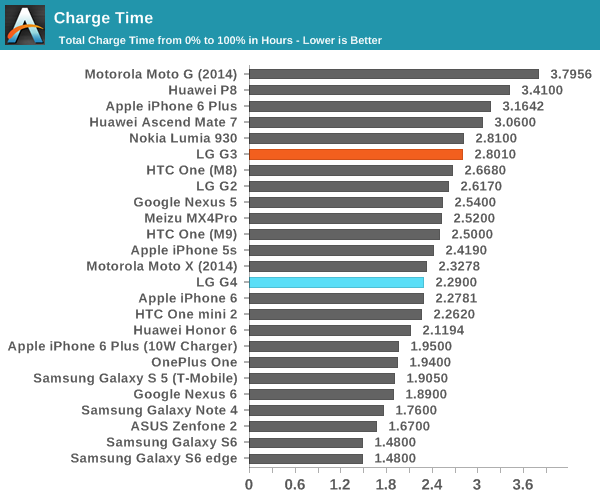
With the standard 5V, 1.8A charger the LG G4 posts a rather standard 2.29 hour charge time. This isn't quite as fast as some other devices that use 9V charging to enable fast charging, but it's definitely not a major issue given that the G4 has good battery life. As far as I can tell, the units that I have don't support QC 2.0 but given LG's statements that QC 2.0 will be supported it should be available on other units, although I'm not sure if LG will support anything higher than 9 volts at 1.3 amps.


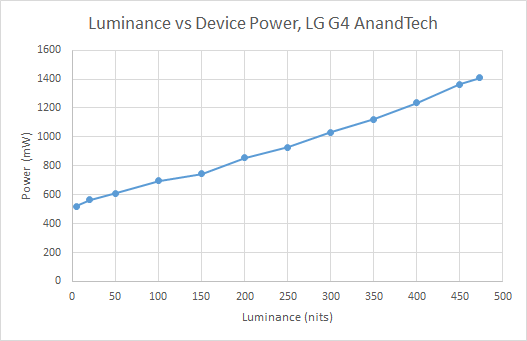
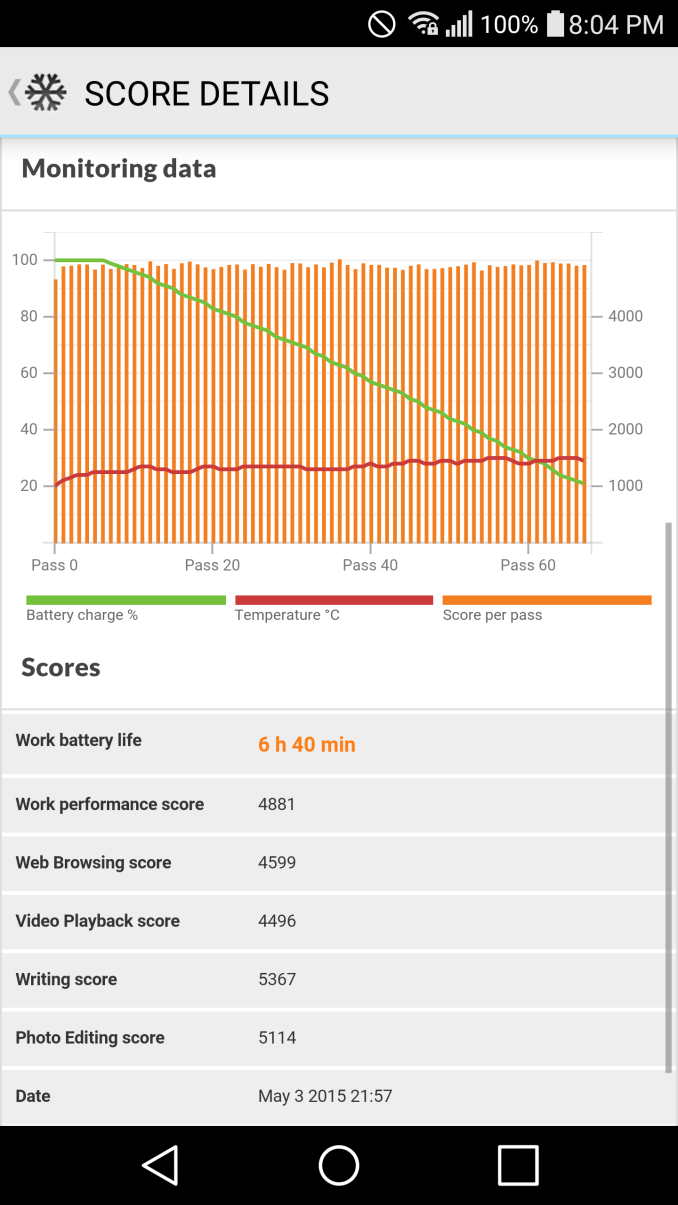
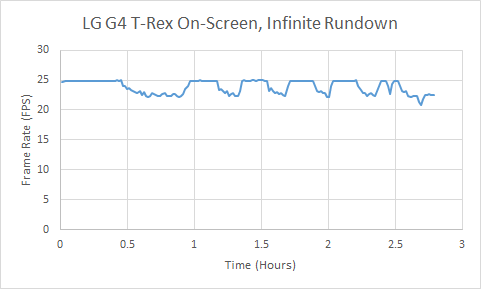
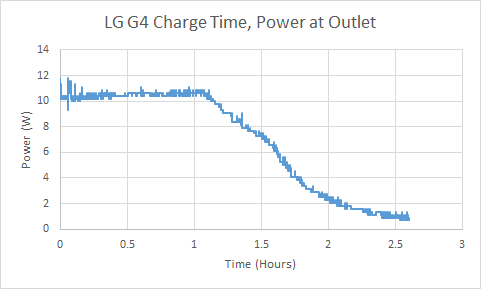








84 Comments
View All Comments
bleached - Sunday, August 2, 2015 - link
http://www.dxomark.com/Mobiles/Column-right/Mobile...Arcetnathon - Wednesday, August 5, 2015 - link
You point something really strange.Each review of tech website published month after release is worst than first tests.
Maybe big company doesn't play fair and send very specific smartphone that will never be in store...
akdj - Thursday, August 6, 2015 - link
As an owner of three of the top 5; S6, Note 4, & indeed... The iPhone 6+, which raps the 'top 5' "Apples is (sic) 'rate' in the top five'The 6+ is indeed produced by Apple ...my subjective feelings are almost identical to Josh's. S6 Edge is an incredible camera. I love it. My Note 4 always has been, with micro SD it makes shooting 4k practical, but my low light shots are pretty sad in comparison to the 6+, as well as 'action' or fast moving shots. S6 shoots 4k, excellent 1080p, but the video stabilization and 60fps-240fps adjustments on the iPhone tump the other two, and I'm just realizing I've placed my response after the wrong reply of your dxo link.
It's saying damn near what Josh concluded. DxoMark is specific to still photography, heavy on resolution and to those ends the sensors in the S6, N4 & G4 indeed play in the same field as the iPhone ...and in some cases beat it. That said, for simplicity point and shoot and nearly every time get an excellent shot without latency or buffering, the iPhone is hard to beat. Without G4 experience I'll hold judgement, but for video, the iPhone is it. For stills, I'm partial now to my S6 and the Note 4 has always been phenomenal
Apple opening their 'souls' a bit with the ability to interact with the SoC ala their native apps, there are plenty of manual control, high resolution shooters (using the 8 megapixel, 4K sensor and its speed) as well as slow motion and video editing tools --- probably the biggest weight in the iphone's favor is the App Store, it's amazing selection of editing and shooting tools as well as continuous updates might just top the subjective list of top 5.
*i don't own a 4K TV but I've got the ability to playback 4K on my MacBook Pro -- looks amazing but it's limited in length of time you can shoot and heats the camera up nice and warm. The S6, all around, my favorite for everything and now my go to camera in most situations. It's smaller and easier to shoot --- but for video capture, my son playing baseball, or last weeks Mötley Crüe show, the iPhone and it's incredible stabilization, video processing and iCloud uploading, ....see where I'm going?
I own a business, have for two decades and with a dozen employees equipped with their choice, I pay for them ...and have iPhone as a personal - S6 personal and Note4 business only. Primarily the stylus and autographs for credit cards has a cool vibe with clientele. You mileage may vary but dxo mark scores in the mid 80s rivals and defeats many point and shoot cams under $300. A point or two difference isn't real world, nor the bible on what to buy. Iphone is ranked 5 & 6 (+ & standard) - can't seem to find the Experia in America and their separation of a couple points in the mid 80as -- without considering motion at all, I'm not sure ANY is the wrong choice and for many that don't want manual control, the iPhone with HDR is hands down the layman's favorite. Android, I'm with the S6, double tap home button to pop the cam and it's rare even as a DSLR shooter that I'm adjusting settings, modes or manually selecting ISO, Aperture or shutter speed
S6 Edge, I love it. 6+, love it. Note 4, still awesome - bit heavier but easily used now with experience and the right case
Take motion into the equation and the limitations on 4K, post processing there of and playback ...I think this is the reason Apple has put this much effort into their sensor as it's the perfect 'size' for non cropped, full sensor 4K shooting
Maybe I'm confused, but I'm ambidextrous, love both and have owned both since 07/08. Dxomark is a silly geek site for resolution of serious optics. Those scores and their differential is hardly a 'win' for any flagship mentioned
J
Pissedoffyouth - Thursday, July 30, 2015 - link
How does the handoff between clusters cope compared to the 810? Does it scale from 2>4 cores when stepping down, averaging the load across the A53 cluster?nikaldro - Thursday, July 30, 2015 - link
The S808 throttles about as much as the exynos 7420.nikaldro - Thursday, July 30, 2015 - link
The S808 throttles about as much as the exynos 7420.grayson_carr - Thursday, July 30, 2015 - link
My God. I thought this review would never come. I already lusted after the G4, bought the G4, owned the G4 for a while, and then bought a Nexus 6 to replace it haha. Still, it will be good to know the Snapdragon 808 lowdown seeing as the Moto X 2015 and Nexus 5 2015 will make use of it.ThisIsChrisKim - Thursday, July 30, 2015 - link
I bought the G4 and I'm really liking it--camera is just superb. UI is meh, but not annoying enough for me to get something else.Nice seeing this review, nonetheless!
grayson_carr - Thursday, July 30, 2015 - link
I liked the G4 (maybe even more than the Galaxy S6 I owned before it), but there were a couple minor annoyances that ultimately led me to buy a Nexus 6. I found that the G4 performed well most of the time, but as mentioned in the review, in some apps it would drop frames more often than the previous two phones I owned (Nexus 5 and Galaxy S6). Also, the touchscreen seemed to be less responsive than the previous phones I owned, which started to get on my nerves. Finally, there were a couple software annoyances like the inability to expand notifications in some circumstances, that were bothering me. I did like the screen on the G4 better than the Galaxy S6 and Nexus 6, and the manual camera controls were boss, but ultimately I prefer the Nexus software experience.Fitnesspro - Thursday, July 30, 2015 - link
Grayson. You are right. Speed and battery count. I liked the G4 specs but was disappointed when tried the phone out at T Mobile. Has a snag and the actual screen id not